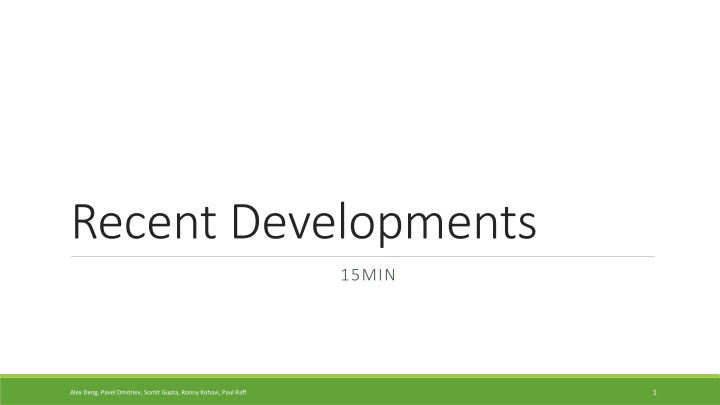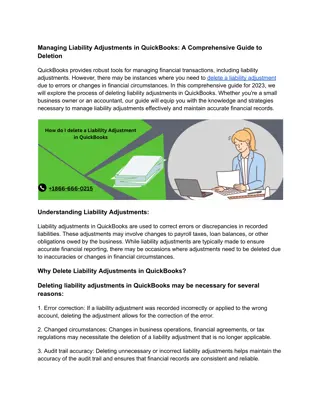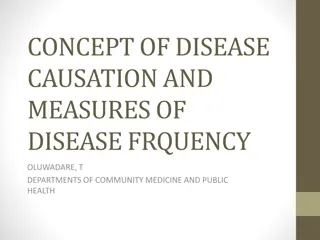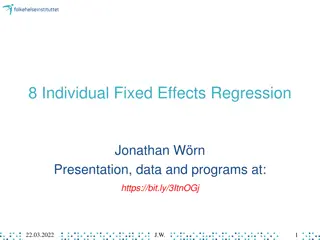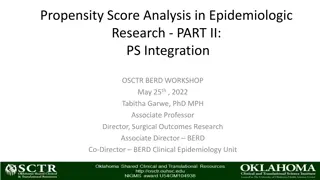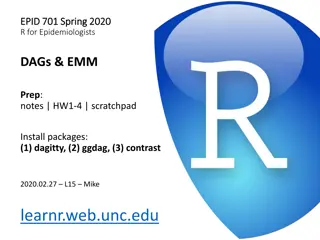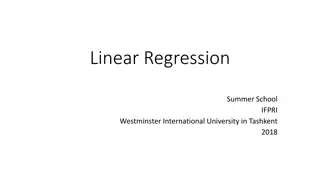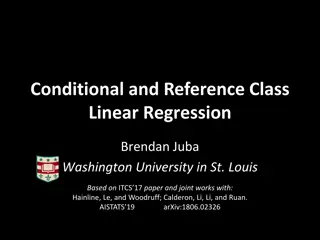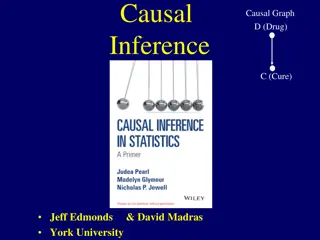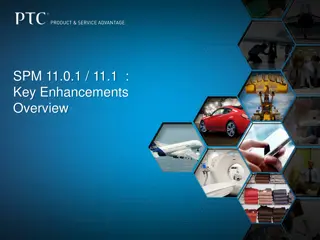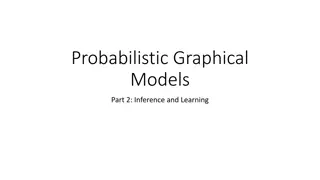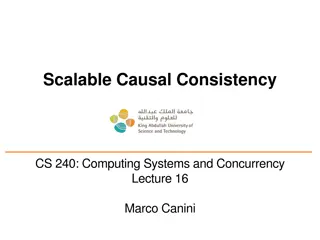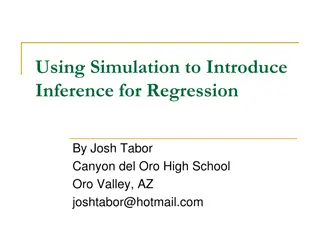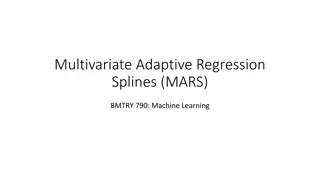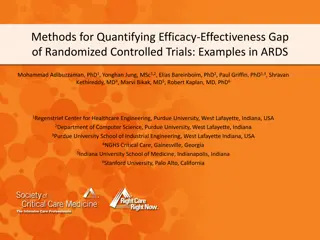Recent Developments in Causal Inference and Regression Adjustment
Recent developments in machine learning for causal inference and regression adjustment are discussed by Alex Deng, Pavel Dmitriev, Somit Gupta, Ronny Kohavi, and Paul Raff. The focus is on beyond Average Treatment Effect, Effect Heterogeneity, Bayesian A/B Testing, and methods like controlled experiments using pre-experiment data. Techniques such as variance reduction, baseline adjustment, and extensions with modern machine learning are explored to improve treatment effect estimation. The importance of covariates and the concept of Population Average Treatment Effect (PATE) are highlighted for a better understanding of treatment effects in diverse subpopulations.
Download Presentation

Please find below an Image/Link to download the presentation.
The content on the website is provided AS IS for your information and personal use only. It may not be sold, licensed, or shared on other websites without obtaining consent from the author.If you encounter any issues during the download, it is possible that the publisher has removed the file from their server.
You are allowed to download the files provided on this website for personal or commercial use, subject to the condition that they are used lawfully. All files are the property of their respective owners.
The content on the website is provided AS IS for your information and personal use only. It may not be sold, licensed, or shared on other websites without obtaining consent from the author.
E N D
Presentation Transcript
Recent Developments 15MIN 1 Alex Deng, Pavel Dmitriev, Somit Gupta, Ronny Kohavi, Paul Raff
Recent Developments Machine learning in Causal Inference Regression adjustment Beyond Average Treatment Effect, a.k.a. Effect Heterogeneity Bayesian A/B Testing Alex Deng, Pavel Dmitriev, Somit Gupta, Ronny Kohavi, Paul Raff 2
Regression adjustment and Variance Reduction is our normal treatment effect estimate. Find another such that 1. ? = ?( ), so both are estimating the same Average Treatment Effect 2. ??? < ???( ), so test based on is more sensitive
Motivation: baseline adjustment mixture model total variance = between-group variance + within-group variance Because of randomization, the proportional of heavy users vs light users (X) might be slightly different between treatment and control. If treatment has more heavy user(baseline), it likely will have bigger revenues/user. Intuitively we need to adjust: ??? (Y) = ? ??? (Y) (?) + ??? ? (Y) (?) Variance explained by X
CUPED (WSDM 2013) Define ? ? ? (?) ? ? = ? ? , AS LONG AS? ? = 0! We call X such that ? ? are things that are not affected by treatment Anything that we know at pre-experiment or pre-treatment triggering time can be considered as X What is ?? Pick the one minimize the variance of ! = 0 COVARIATE or baseline. Intuitively X We call it Controlled Experiment Using Pre-Experiment Data
Extension with modern Machine Learning Y ? ? is a Linear Adjustment (We found it often good enough) Better adjustment is to find optimal adjustment in ? ?0 ?1? where ?1? and ?0? are fit of ?1? = ?(??|?), and ?0? = ? ??? ?1 ?0? Any regression method, e.g. boosting, forest can be used here to fit ?1 and ?0 Any ?1 and ?0 can be used and is still unbiased. But better regression fit means more variance reduction But covariates X must be pretreatment (or things we are sure not affected be the treatment). This is an important constraint on predictors we can use in machine learning models!
Beyond Average Treatment Effect When we say treatment effect most cases we refer to Population Average Treatment Effect (ATE or PATE) We know treatment effect differs from unit to unit A feature might not be popular in some markets -> improvement A feature might be broken on one browser -> bug There could be many micro-structure in subpopulations, where treatment effect varies, or even flip sign! Heterogeneous Treatment Effect (HTE): Hot topic in Economics/Policy Evaluation, Personalized/precise Treatment/Drug, etc. Alex Deng, Pavel Dmitriev, Somit Gupta, Ronny Kohavi, Paul Raff 7
Browser difference Alex Deng, Pavel Dmitriev, Somit Gupta, Ronny Kohavi, Paul Raff
Weekend vs weekday Alex Deng, Pavel Dmitriev, Somit Gupta, Ronny Kohavi, Paul Raff
Shift Alex Deng, Pavel Dmitriev, Somit Gupta, Ronny Kohavi, Paul Raff
CATE: Conditional Average Treatment Effect Potential Outcomes with covariates and assignment T: (? 1 ,? 0 ,?,?) Interested in predicting individual treatment effect (ITE): ? 1 ?(0) given ? Best prediction is ?1? ?0? , i.e. the regression ?(? 1 ?(0)|?), a.k.a. conditional average treatment effect (CATE) 11 Alex Deng, Pavel Dmitriev, Somit Gupta, Ronny Kohavi, Paul Raff
Meta Learners T-Learner: fit model for separately ?1X and ?0X using treatment group and control group data S-Learner: fit one model ?(?,?) using combined data Both need to strike balance between bias and variance. Popular base learners: Random Forest, BART(Bayesian additive regression tree), Lasso But bias of ?1X and ?0X can be misinterpreted as treatment effect Recent development: Treat ?1 and ?0 as nuisance parameter, directly model CATE as function of X, and put regularization/sparsity on form of CATE(?) Targeted Learning, Double ML, U-Learner 12
Overfit or not overfit? Kunzel et al., 2017. Figure 1.a Alex Deng, Pavel Dmitriev, Somit Gupta, Ronny Kohavi, Paul Raff 13
Bayesian A/B Tests Many published research findings found not reproducible. Notable/Surprising results even more so Many results with small p-value fails Twyman s law Winner s curse: stat sig results often lead to biased estimate Hard to Interpret correctly Common mistake is to interpret p-value as P(?0|????) This finding did not reach statistical significance(p=0.054), but it indicates a 94.6% probability that statins were responsible for the symptons --- an article on adverse effect of statin published in JAMA P-value hack Unable to Accept Null If desired result is not to reject the null, just run a small sample experiment 14 Alex Deng, Pavel Dmitriev, Somit Gupta, Ronny Kohavi, Paul Raff
P(H0|Data), not P(Data|H0) P(H1|Data) is the Bayesian posterior belief of the alternative hypothesis, it is closely related to the concept of FDR (False discovery Rate) P(H1|Data) = 1- P(H0|Data) represents the confidence of a correct ship decision P(H0|Data) and P(H1|Data) are auto-adjusted for multiple testing adjustment if metrics movements are independent (why should you care about hundreds of other unrelated tests?) Alex Deng, Pavel Dmitriev, Somit Gupta, Ronny Kohavi, Paul Raff
Bayesian Two Sample Hypothesis Testing: full symmetry! 1. H0 and H1, with prior odds ? ?1 ? ?0 ????????? = 2. Given observations, likelihood ratio ? ???? ?1 ? ???? ?0 ??(???? ?????? ????? ??????) = 3. Bayes Rule ? ?1 ???? ? ?0 ???? = ????????? ?? =? ?1 ? ???? ?1 ? ???? ?0 = ????????????? ? ?0 ???????? 1+???????? 4. ? ?1 ???? = Alex Deng, Pavel Dmitriev, Somit Gupta, Ronny Kohavi, Paul Raff
But we dont know P(H0) and P(H1) We don t even know ? ???? ?1 because we don t know what is the distribution of effects under H1 Solution: use historical experiments data to estimate P(H0) and also distribution of effects under H1 Cold start problem: what if we don t have rich historical data? How to know whether historical experiments are similar to the current one we are testing? Using Rich Historical Experiment Data Alex Deng, Pavel Dmitriev, Somit Gupta, Ronny Kohavi, Paul Raff
Remarks on Bayesian Test Bayesian Test automatically provide adjustment/correction for Continuous decision making/peeking Multiple testing (majority, but not all forms) Winner s curse (posterior mean offers a better estimate) PROVIODED: You know the true prior P(H0), P(H1) and the model for P(Data|H1) In practice, subjectively providing these prior has the same shortcomings of p-hack. We can call this prior-hack A noninformative prior is objective and seems to avoid prior-hack. But there is no truly noninformative priors. Assuming effect size ? uniform wrongly believes it is equally likely to have a very large effect than a small effect (a BIG assumption). When running A/B tests at scale with rich historical data, we should learn prior from empirical data: empirical Bayes 18
References Deng et al., 2013: Improving the Sensitivity of Online Controlled Experiments by Utilizing Pre-Experiment Data Peysakhovich and Eckles, 2017: Learning causal effects from many randomized experiments using regularized instrumental variables Kharitonov et al., 2017: Learning sensitive combinations of a/b test metrics Deng et al., 2017 : Continuous monitoring of A/B tests without pain: Optional stopping in Bayesian testing Deng, 2015: Objective Bayesian two sample hypothesis testing for online controlled experiments Wager and Athey, 2015: Estimation and Inference of Heterogeneous Treatment Effects using Random Forests Tian et al., 2012:A Simple Method for Detecting Interactions between a Treatment and a Large Number of Covariates Deng et al., 2017: Concise Summarization of Heterogeneous Treatment Effect Using Total Variation Regularized Regression Tansey et al., 2017: Interpretable Low-Dimensional Regression via Data-Adaptive Smoothing Zhao et al., 2017: Selective inference for effect modification via the lasso Kunzel et al., 2017: Meta-learners for Estimating Heterogeneous Treatment Effects using Machine Learning Alex Deng, Pavel Dmitriev, Somit Gupta, Ronny Kohavi, Paul Raff 19
Questions? http://exp-platform.com Alex Deng, Pavel Dmitriev, Somit Gupta, Ronny Kohavi, Paul Raff
Appendix 21 Alex Deng, Pavel Dmitriev, Somit Gupta, Ronny Kohavi, Paul Raff
Targeted Learning/Remove Nuisance Parameter ? 1 = ?1? + ?,? 0 = ?0? + ? ? ? = ? ?1? ?0? + ?0? + (? ?) We don t care about ?0? , only care about ? ? =?1? ?0? Take conditional expectation given X on both sides ? ? ? = ? ? ? ? ? + ?0(?) Subtract the two ? ? ? ? = T E T X ? ? + (? ?) ?0 is removed! Also ?(?|?) is known in randomized experiment. Fit a model ?(?) for ? ? ? , plug in ? for ?(?|?), fit the model for ? ? , put sparsity constraints on ? ? for better interpretation (Deng et al. 2017, Tansey et al. 2017) Surprise! In randomized experiment, the fit ?(?)doesn t need to be unbiased. In fact, Tian et. al. 2014 uses a working model of a constant ?. A better ? reduces variance! 22 Alex Deng, Pavel Dmitriev, Somit Gupta, Ronny Kohavi, Paul Raff
